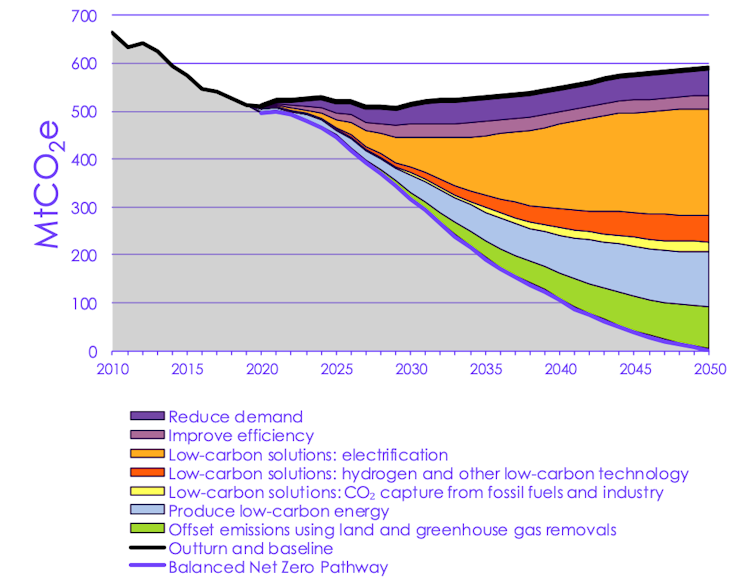UK target to cut emissions 78% by 2035 is world-leading – but to hit it, action is needed now

A blog from Professor Piers Forster, Director of the Priestley International Centre for Climate
Every day I’m inundated with fresh news of businesses and governments declaring new deadlines for when they’ll reach net zero emissions. The announcement of one climate target in particular caught my attention recently, for the simple fact that I and my colleagues in the Climate Change Committee – the independent body of experts established to advise the UK government on climate action – helped design it.
Under the Climate Change Act of 2008, the UK government must set five-year emission reduction targets, otherwise known as carbon budgets. By adopting the advice in our sixth carbon budget, the government set a new legally-binding target to cut the country’s greenhouse gas emissions 78% by 2035 compared to 1990 levels.
This amounts to a 60% reduction on today’s levels, and is probably the strongest legally-binding target in the world. If the government fails to meet this target, it would be guilty of breaking its own laws. It’s one of the few national targets that is actually compatible with holding global temperature rise below the Paris Agreement’s 1.5°C limit. In the US, President Joe Biden recently vowed his country would halve its emissions by 2030 – almost double the target of 28% which Barack Obama set in 2014.
There is cause for optimism in these increasingly ambitious net zero targets. But only on one condition: that these long-term promises are matched with short-term action.
Early decisions matter
After more than ten years of environmentalists lobbying the Department for Transport, aviation and shipping is finally included in the UK’s carbon budget under this updated net zero target. And 78% was not plucked from thin air – it represents a milestone on a carefully researched pathway that stretches from today’s emissions levels to net zero in 2050. This pathway includes a timed roll-out of policies and technologies, as well as expected changes in behaviour, that we think are realistic over the next three decades, and which can get the UK to carbon-neutrality at a reasonable cost.

The Climate Change Committee/Department for Business, Energy & Industrial Strategy, Author provided
Meeting net zero targets in 2035, or 2050, will depend on policy decisions and public and private investments being made in 2021. Governments tend to like flashy projects like zero-carbon planes or nuclear fusion, but these are no substitute for a fully-funded, comprehensive strategy for transforming society on a strict timeline.
In transport, the government’s net zero strategy must involve rolling out charging stations at speed, so half of new cars can be battery-powered within five years. It must also ensure car and plane travel falls, rather than rebounds to ever higher levels post-pandemic. This is an area the government will probably have to intervene in, especially as it plans to build more roads and airport expansions are still on the cards. For heavy goods vehicles, new start-up companies or established manufacturers need to start selling zero-carbon lorries, as nearly all new sales will need to be zero-carbon by 2035.
In construction, the UK needs the skills, regulations and access to finance to retrofit old homes, install low-carbon heating and create green new-builds. Just as an example, heat pump installation must go from more or less a standing start to around half a million each year within five years.
The UK must also double its renewable energy capacity over the next five years and start installing carbon capture technologies on new gas power plants. Industries must become more energy efficient and make low-carbon products that last. There must be significant investment in hydrogen and carbon capture technologies so we can remove at least five million tonnes of carbon dioxide from the atmosphere a year by 2030.
More food will need to be grown on significantly less land, making way for the restoration of carbon-soaking peatlands and forests. And each person living in the UK will need to change their eating habits within five years to cut meat and dairy consumption by at least 10%.
Working with a net zero target means there is no wriggle room. Sectors that are hard to decarbonise, such as aviation and farming, can’t rely on other sectors to bail them out with their own emissions cuts – they’ll need to innovate to reach net zero.
The road to net zero
To keep the 1.5°C goal in sight, rapid global change is needed. We need new ways of sharing knowledge and learning from our mistakes. Huge costly errors, such as the Northern Ireland renewable heat incentive scandal, which saw wood being burnt to heat empty sheds just to secure subsidy payments, or the UK government’s recent decision to scrap the green home grant scheme, must be learned from so that we can brush ourselves off and try again.
By laying out a roadmap to net zero emissions for the UK government to follow, my colleagues and I at the Climate Change Committee hope to present an optimistic vision of the future. We want to show our children that change is possible, and give them hope for new jobs and new creative outlets that can let us build a net-zero society that is healthier, happier and more resilient.
Now that the government has adopted our targets for decarbonising the UK over the coming decades, our team must adapt to monitor their progress across every department. We will hold this and any future government’s feet to the air-source heat pump until they deliver on their promises.![]()
This article is republished from The Conversation under a Creative Commons license. Read the original article.
